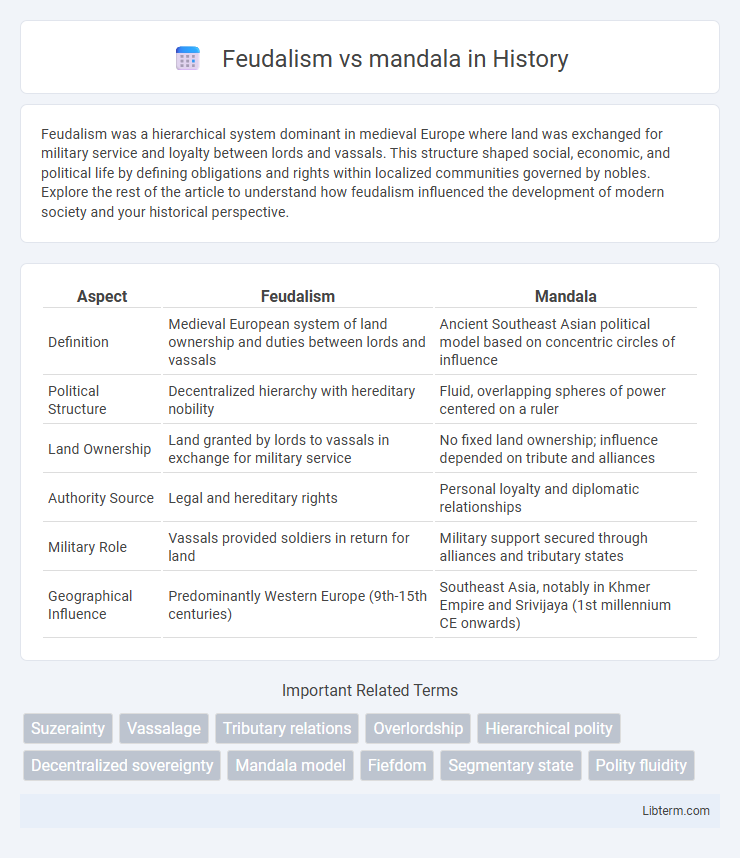Feudalism was a hierarchical system dominant in medieval Europe where land was exchanged for military service and loyalty between lords and vassals. This structure shaped social, economic, and political life by defining obligations and rights within localized communities governed by nobles. Explore the rest of the article to understand how feudalism influenced the development of modern society and your historical perspective.
Table of Comparison
| Aspect | Feudalism | Mandala |
|---|---|---|
| Definition | Medieval European system of land ownership and duties between lords and vassals | Ancient Southeast Asian political model based on concentric circles of influence |
| Political Structure | Decentralized hierarchy with hereditary nobility | Fluid, overlapping spheres of power centered on a ruler |
| Land Ownership | Land granted by lords to vassals in exchange for military service | No fixed land ownership; influence depended on tribute and alliances |
| Authority Source | Legal and hereditary rights | Personal loyalty and diplomatic relationships |
| Military Role | Vassals provided soldiers in return for land | Military support secured through alliances and tributary states |
| Geographical Influence | Predominantly Western Europe (9th-15th centuries) | Southeast Asia, notably in Khmer Empire and Srivijaya (1st millennium CE onwards) |
Introduction to Feudalism and Mandala
Feudalism was a medieval European social system where land was exchanged for military service, creating a hierarchy of lords and vassals bound by mutual obligations. The Mandala model, prevalent in Southeast Asia, operated as a decentralized political structure with fluid boundaries, relying on a central ruler exerting influence over surrounding tributary states. Both systems structured power and land management but differed fundamentally in territorial control and political organization.
Historical Origins of Feudalism
Feudalism originated in medieval Europe after the fall of the Roman Empire, characterized by a decentralized political system where land was exchanged for military service and loyalty among nobles and vassals. This socio-political structure evolved from the collapse of centralized authority, leading to localized power bases centered on manorial estates. Unlike the Asian mandala system, which emphasized a more fluid and overlapping hierarchy of allegiance radiating from a central ruler, feudalism relied on rigid, hereditary bonds and land tenure.
Historical Roots of the Mandala System
The Mandala system, rooted in ancient Southeast Asian political organization, contrasts with European feudalism by emphasizing a network of flexible, overlapping allegiances rather than fixed territorial lordship. Originating from Indian cultural and political influences, the Mandala model centered power around a dominant king whose authority radiated outward through tributary states and vassal relationships without rigid boundaries. This historical framework allowed Southeast Asian polities to operate as dynamic, decentralized entities prioritizing diplomacy and vassalage over hereditary land ownership that characterized feudalism.
Key Characteristics of Feudalism
Feudalism is defined by a rigid hierarchical structure based on land ownership and vassalage, where lords granted land (fiefs) to vassals in exchange for military service and loyalty. The system is decentralized, with local lords exercising significant autonomous control over their territories, while serfs worked the land under obligations to their lords. Key characteristics of feudalism include a reciprocal relationship between lords and vassals, hereditary privileges, and a stratified social order centered on agrarian economies.
Core Features of the Mandala Model
The mandala model centers on a decentralized political system where power radiates from a central ruler to surrounding tributary states, contrasting with feudalism's hierarchical land-based vassalage. Core features include fluid boundaries, reciprocal alliances, and overlapping sovereignties that emphasize diplomacy and tribute over direct control. This system fosters flexible governance adaptable to diverse cultural and geopolitical landscapes in Southeast Asia and South Asia.
Political Structure: Feudalism vs. Mandala
Feudalism is characterized by a hierarchical political structure based on land ownership and vassalage, where power is decentralized and local lords owe allegiance to a monarch. The Mandala model centers on a flexible, concentric political organization where a central ruler exerts influence over surrounding states through alliances and tribute rather than direct control. While feudalism relies on rigid territorial boundaries and legal bonds, the Mandala system emphasizes fluid borders and relational authority among regional powers.
Power Dynamics and Authority Distribution
Feudalism is characterized by a hierarchical distribution of power centered around land ownership and vassal-lord relationships, where authority is rigidly defined and localized within feudal estates. In contrast, the Mandala system features a more fluid and overlapping structure of authority based on alliances, tribute, and shifting loyalties among multiple political centers. Power dynamics in mandalas are decentralized and networked, allowing for flexible control and influence, unlike the fixed territorial sovereignty found in feudal hierarchies.
Socio-Economic Organization Comparison
Feudalism structured socio-economic organization through a hierarchy of lords and vassals bound by land-based obligations and mutual protection, creating a decentralized political economy centered on agricultural estates. In contrast, the mandala system featured a concentric political model with a core ruler exerting influence over tributary states through economic flow and military alliances, resulting in a networked and fluid socio-economic structure rather than fixed territorial control. Feudalism emphasized land tenure and hereditary rights, whereas mandalas prioritized strategic relationships and exchange networks for economic stability.
Influence on Regional Governance and Stability
Feudalism structured regional governance through rigid hierarchies where landholding lords exercised autonomous control, fostering local stability but often leading to fragmented political authority. The Mandala model represented a more fluid, concentric system of overlapping allegiances centered around a powerful ruler, enabling flexible diplomacy and shifting power dynamics that maintained regional influence without rigid territorial boundaries. Both systems shaped stability by balancing decentralization and central authority, with feudalism emphasizing land-based loyalty and mandalas prioritizing relational sovereignty.
Lasting Legacies and Modern Relevance
Feudalism established enduring social hierarchies and land-based power structures that shaped medieval Europe and influenced modern property rights and decentralized governance. The mandala system, prominent in Southeast Asia, promoted flexible political alliances centered on tribute and influence rather than fixed territorial control, impacting contemporary regional diplomacy and state interactions. Both frameworks contribute to understanding governance evolution, regional state relationships, and the legacy of decentralized authority in modern political systems.
Feudalism Infographic

 libterm.com
libterm.com